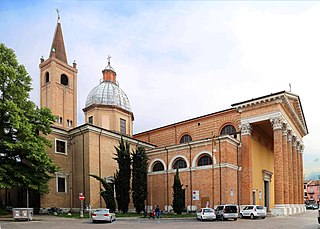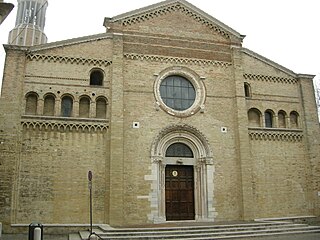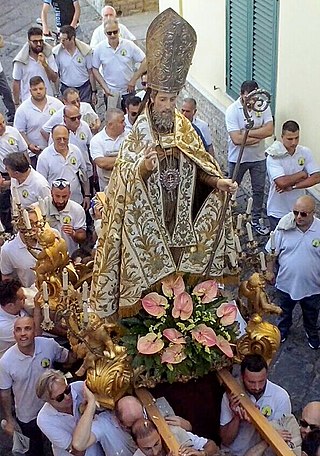Atella was an ancient Oscan city of Campania, located 20km directly north of Naples.
Aveia was an ancient town of the Vestini and Roman former bishopric, which remains a Latin Catholic titular see.

Bobbio Abbey is a monastery founded by Irish Saint Columbanus in 614, around which later grew up the town of Bobbio, in the province of Piacenza, Emilia-Romagna, Italy. It is dedicated to Saint Columbanus. It was famous as a centre of resistance to Arianism and as one of the greatest libraries in the Middle Ages. The abbey was dissolved under the French administration in 1803, although many of the buildings remain in other uses.

The Diocese of Imola is a Latin Church diocese of the Catholic Church in Romagna, northern Italy. It is a suffragan of the Archdiocese of Bologna. The diocese had originally been a suffragan of the metropolitan of Milan, and was then subject to the Archbishop of Ravenna until 1582, when Pope Gregory XIII made Bologna an archbishopric and assigned it two suffragans, Imola and Cervia. In 1604, however, Pope Clement VIII returned them to the metropolitanate of Ravenna. Pope Pius VII transferred Imola back to the metropolitanate of Bologna.

The Diocese of Rimini is a Latin Church ecclesiastical territory or diocese of the Catholic Church in Emilia Romagna, Italy. From earliest times, it was a suffragan to the Holy See, despite repeated attempts by the Diocese of Ravenna to claim it as a suffragan diocese. Since 1604, however, it has been a suffragan of the Archdiocese of Ravenna-Cervia.

The Archdiocese of Ravenna-Cervia is an archdiocese of the Catholic Church. It is a metropolitan see of the Latin Church, located in the Emilia-Romagna region of Italy.

In Christianity, the translation of relics is the ceremonial removal of holy objects from one place to another. Usually only the movement of the remains of a saint's body would be treated so formally, with secondary relics such as items of clothing treated with less ceremony. Translations could be accompanied by many acts, including all-night vigils and processions, often involving entire communities.

Gerontius of Cervia was an Italian bishop of Cervia who is venerated as a saint.
Terentian(us) (Italian: San Terenziano) (died 118) was Bishop of Todi who was killed during the reign of Hadrian (117–138).

The Diocese of Forlì-Bertinoro is a Latin diocese of the Catholic Church in Romagna, Italy. Until 1986 it was known as the Diocese of Forlì, in existence perhaps from the fourth century. In that year the Diocese of Bertinoro was united to it. The diocese is suffragan to the Archdiocese of Ravenna-Cervia.

The Diocese of Fano-Fossombrone-Cagli-Pergola is a Latin diocese of the Catholic Church in Italy, created in 1986, when the historical Diocese of Fano was united to the Diocese of Cagli e Pergola and the Diocese of Fossombrone. It is a suffragan of the Archdiocese of Pesaro.

The Catholic diocese of Fossombrone existed in the Italian province of Pesaro and Urbino, in the comune of Fossombrone, in the valley of the Metaurus River, 25 km southwest of the Adriatic seaport of Fano. In 1986, the diocese was suppressed and its territory incorporated into the diocese of Fano-Fossombrone-Cagli-Pergola. Up to 1563, the diocese had been directly subject to the papacy. It then became a suffragan of the archdiocese of Urbino. In 2000, Urbino lost its metropolitan status, and Fossombrone became part of the ecclesiastical province of Pesaro.

Palatias and Laurentia are martyrs venerated by the Roman Catholic and Eastern Orthodox churches. According to tradition, Palatias or Palatia was an aristocratic Roman woman who was converted to Christianity by her wet nurse or slave Laurentia. They were executed for being Christians at Fermo, in present-day Italy, during the reign of Diocletian.

Saint Orontius of Lecce is venerated as a saint by the Catholic Church, along with two other figures associated with his legend, Fortunatus and Justus. He is viewed as the first bishop of Lecce.

Quirinus is venerated as an early bishop of Sescia, now Sisak in Croatia. He is mentioned by Eusebius of Caesarea.
Laurence of Siponto, also known as Laurence Maioranus, is an Italian saint, patron of the city of Manfredonia and the Archdiocese of Manfredonia-Vieste-San Giovanni Rotondo. Manfredonia Cathedral is dedicated to him. He is credited with founding the shrine to Saint Michael the Archangel on Mount Gargano.
Saint Pardus is a Roman Catholic saint associated with Larino in Italy. Larino Cathedral is dedicated to him.
Saint Vicinius or Saint Vicinius of Sarsina was the first bishop of Sarsina and is venerated as a Roman Catholic saint.
Civitella d'Arna is a frazione of the comune (municipality) of Perugia in central Italy, and the Ancient city and former bishopric Arna, which remains a Latin Catholic titular see.

Elpidius of Atella, or Elpidio in Italian, is a Christian saint. He was a bishop of the city of Atella, from 432 for about 20 years.















